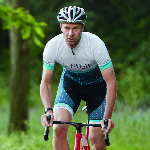
Unless you’re racing cyclocross, winter is prime time off-season. That typically means lots of lower-intensity base miles, often done on an indoor stationary trainer (with maybe a few crazy outdoor challenges thrown in for fun). But what about strength training? Does an endurance sport like cycling really require this type of cross-training?
If you talk to cyclists, you’re bound to get a variety of answers. Here are a few things I’ve heard over the years:
1) Cyclists don’t need muscles in their arms or shoulders.
2) Cyclists don’t need strong core muscle.
3) Cyclists don’t need to stretch.
4) Cyclists only need to strengthen their legs.
Which of these statements is true? Number 5: None of the above. They’re all false. Let’s have a look at why.
The Importance of Total-Body Strength Training for Cyclists
First and foremost, strength training helps prevent injuries—a stronger body can handle more workload before breaking down. Getting your entire body strong will also help improve your performance.
You’ve probably heard the saying “the chain is only as strong as the weakest link.” It sounds like something my dad would say, but it’s true! For example, take a look at our current men’s UCI road world champion, Peter Sagan. His body looks more like that of a middleweight boxing champion than of a stereotypically scrawny cyclist. He has quite a muscular body, including strong shoulders and arms. I can’t see any weak link in his chain of muscles. And that’s probably part of the reason why he’s the cycling legend that he is. His body is well-balanced and that helps him to perform.
Looking at myself, my weakest link was always my lower back. Every year during the first stage in the big mountains of the Giro d’Italia or the Tour de France, it would hurt like mad. The pain was a result of demanding too much from my weak lower-back muscles. Strengthening them would have clearly helped me ride better, so here I am saying, “Do as I tell you and not as I did.”
Speaking of the midsection, core muscles are a crucial part of a bike rider’s chain of muscles. A lot of the strength you muster to push harder and pedal faster is generated here. If you’re ever short on time or motivation, then prioritize core work (and stretching) over arm and shoulder exercises, or find moves—like planks—that work all three.
I cannot emphasize the importance of core work enough. It helps stabilize your position on the bike. When you have a strong core, you’ll be able to pedal without rocking your upper body as much. And let’s face it, we all dream of looking as fluid and elegant on the bike as British rider David Millar did.
How to Strength Train for Cycling
You don’t need an expensive machine or a gym membership to do some basic strength-training exercises. Spending 15 to 20 minutes on some simple bodyweight exercises before you head out for your ride is all you need.
If you have an exercise ball, it can be a great tool for working multiple muscles at the same time. If not, old-fashioned sit-ups will get the job done. Just be sure to also add in some basic back exercises, as well as some push-ups and chin-ups and you’ll be good to go. A routine like this may not get you to Peter Sagan’s level, but that’s ok. Not all of us have the ambitions to become a two-time world champion, right?
There are also ways to do strength work on the bike during your rides. Back in East Germany, we used to do training called “K3,” which consisted of three sets of 10 or 20 minutes of climbing, maintaining a cadence of 50 (meaning you take 50 pedal strokes per minute). During this exercise you stay seated and push a big gear that still allows you to stay within an aerobic heart rate zone (fat burn or cardio), so that lactic acid doesn’t build up.
We would do the K3 program before the season started to increase our endurance and stamina. It strengthens your muscles and and teaches them to work efficiently under stress for a long period of time.
To sum things up, I strongly believe that a combination of core-muscle training and stretching at home before the ride, plus some specific exercises on the bike, not only helps your performance but also helps your body to recover quicker and stay injury-free. So let’s put strength training on our off-season calendar, shall we?
This information is for educational purposes only and is not intended as a substitute for medical diagnosis or treatment. You should not use this information to diagnose or treat a health problem or condition. Always check with your doctor before changing your diet, altering your sleep habits, taking supplements, or starting a new fitness routine.

Jens Voight is one of the toughest cyclists ever, loved watching him in the Tour de France. Everyone who follows the sport misses Jen. “Shut Up Legs!”